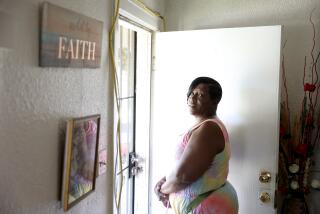Welfare Reform Successes Face Subsidy Cutoff
- Share via
SACRAMENTO — The first success stories from California’s welfare reform are just months away from losing the child care subsidy that freed them to work.
In Los Angeles, an estimated 5,200 parents--mostly mothers--who got off welfare and found jobs will hit the two-year cutoff for child care assistance between January and June. Statewide, about 13,000 people will lose the money, according to reports released at a Capitol hearing Monday to consider options for extending the subsidy.
Were those people to return to welfare, they could again qualify for child care. But for some, that is unthinkable.
“If this is taken away, there’s absolutely no way I would be able to keep my job,” said Linda Wibberly, a Sacramento mother of two who left welfare two years ago after finding a job with a billing company.
Despite a promotion and raise, Wibberly said, her salary barely pays her bills, not to mention her $800-a-month child care costs. But “I can’t go back on welfare. . . . You can’t imagine how degrading it is,” she said.
Originally, the state had promised Wibberly and other welfare reform participants child care assistance until they reached 75% of the state median income, or about $29,000 a year for a family the size of hers.
But last spring, Gov. Gray Davis cut from the budget $50 million for extending the child care. At the time, Davis indicated he was philosophically opposed to any extension beyond what is offered the working poor who qualify for a similar voucher program.
The Sacramento hearing was intended to warn Davis of the consequences of his action before he completes his new budget proposal in early January.
“Working men and women are going to say, ‘It’s not worth it!’ and not get off aid,” said Assemblyman Gil Cedillo (D-Los Angeles), who chairs an Assembly budget subcommittee. “Ultimately, we’re going to spend the money. It’s going to be on child care and education or it’s going to be on prisons and welfare.”
This year, the state budgeted $1.2 billion to pay child care costs for 265,600 children of welfare recipients. To qualify, their parents must be working or actively seeking employment, part of the state’s response to the 1996 federal overhaul of welfare.
However, because of Davis’ veto, only $17.5 million was set aside for success stories like Wibberly. As a result, last month Wibberly received notice that her child care subsidy will end Dec. 31.
“What’s going to happen now?” Wibberly asked the panel, crying. “I cannot leave my babies home alone. It’s not safe.”
Other mothers who testified included an electronics engineer who accused the state of pulling the carpet out from under her, a hairdresser with 4-year-old twins who is back to work after several years on welfare, and a woman who pulled herself from homelessness through a community college degree and employment. All are single parents.
“These families have done everything they were asked to do to get out of the welfare system,” said Sandra Edelbrock, the children’s services administrator from Riverside County, where child care benefits for about 775 people will expire by June.
Meanwhile, a new study by UC Berkeley shows that in Los Angeles County, only 20% of those eligible for the child care subsidy are using it, compared to about 30% statewide, signaling deeper problems.
“We’re seeing a lot of chaos,” said Bruce Fuller, co-director of Berkeley’s Policy Analysis for California Education think tank.
The underuse problem is just beginning to be studied, through a series of focus groups being coordinated by the Berkeley think tank.
Women report a variety of obstacles. Some blame the long waiting lists for licensed child care centers, mistakenly assuming they must use a center to qualify for the vouchers.
Other women said friends and relatives who care for their children were hesitant to go through the fingerprint check required by the state before vouchers can be issued.
Complications with paperwork also were cited. One Los Angeles woman said her subsidy was cut after she forgot to file a form while she was pregnant, believing that state disability had taken over for welfare after her doctor told her she could no longer work.
Exacerbating child care shortages, centers and private providers are reluctant to accept the vouchers, women said, because they must accept them as full payment even though on average they pay only 75% of fees.
From the caregivers’ perspective, the vouchers are a risky deal, with three- to four-month delays before reimbursement begins, the researchers have found. Women on welfare receive them after signing a contract that commits them to complete their resumes and apply for jobs. If they renege on their part of the deal, the vouchers become worthless and the caregiver is not reimbursed.
When children are sick, some women reported, case workers sometimes refuse to pay the centers for those days even though the centers charge by the month regardless of attendance.
More to Read
Get the L.A. Times Politics newsletter
Deeply reported insights into legislation, politics and policy from Sacramento, Washington and beyond. In your inbox three times per week.
You may occasionally receive promotional content from the Los Angeles Times.










